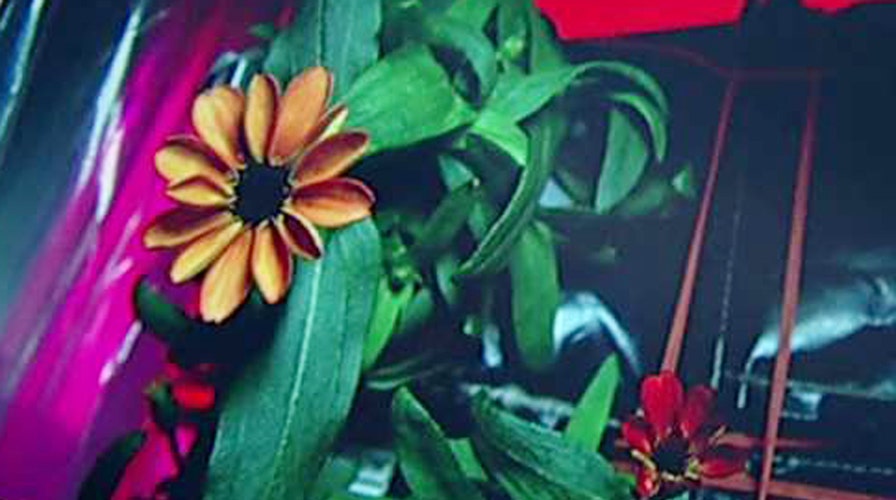Astronauts aboard ISS grow first flower in space
Scientists say this could get us closer to farming on Mars
NASA astronaut Scott Kelly is proving quite the gardener in space.
Over the weekend, he tweeted out an image of what he described as the first flower grown in space.
First ever flower grown in space makes its debut! #SpaceFlower #zinnia #YearInSpace pic.twitter.com/2uGYvwtLKr
— Scott Kelly (@StationCDRKelly) January 16, 2016
It may not match the exploits of astronaut Mark Watney, the Matt Damon character in the movie “The Martian” who survives on Mars in part by growing potatoes. But nonetheless, it is a small step towards NASA's goal of one day developing bioregenerative food production systems for the space station and long-duration exploration missions.
And it comes after several setbacks to the Veggie plant growth facility, which was installed on the orbiting laboratory in early May of 2014.
Relevant: International Space Station celebrates 15th birthday
“While the plants haven’t grown perfectly,” Gioia Massa, NASA science team lead for Veggie, said in a statement. “I think we have gained a lot from this, and we are learning both more about plants and fluids and also how better to operate between ground and station. Regardless of final flowering outcome we will have gained a lot.”
The first crop – ‘Outredgrous’ red romaine lettuce – was activated for growth. But things didn’t get off to a great start.
Related: Space Station astronauts make history, eat first space-grown veggies
“We lost two plants due to drought stress in the first grow out and thus were very vigilant with respect to the second crop,” Trent Smith, Veggie project manager, said in a statement.
The second crop of the same lettuce was activated in early July by NASA astronaut Scott Kelly, and thanks to lessons learned from the first run, adjustments to watering and collecting imagery of the plants were made. The leafy greens grew according to schedule, with only one plant pillow not producing. The crew even ate the lettuce.

(NASA)
The next crop on the docket was a batch of zinnia flowers.
“The zinnia plant is very different from lettuce,” Smith said. “It is more sensitive to environmental parameters and light characteristics. It has a longer growth duration between 60 and 80 days. Thus, it is a more difficult plant to grow, and allowing it to flower, along with the longer growth duration, makes it a good precursor to a tomato plant.

Mold growth initially grew on the plant in pillow E in the bottom left corner of the plant mat. Credits: NASA (NASA)
The zinnia plant, though, showed signs of stress early on - possibly due to high humidity or water engulfing some of the plants. “When you have high humidity and wet surfaces,” Smith said, “leaves start dying, and become prime real estate for mold to grow.”
Related: NASA wants to put rodents on space station
Kelly, who took over garden duties after NASA astronaut Kjell Lindgren returned to Earth on Dec. 18, cut away the affected, moldy plant tissue. The plant surfaces and plant pillow surfaces were sanitized with cleaning wipes, and the fans continued at a high speed in hopes of keeping the Veggie chamber dried out and mold growth abated.
By Christmas Eve, though, Kelly called down to say the high fan speed was drying out the crop too much. But the next scheduled watering was not until Dec. 27.
“I think that would be too late,” Kelly told the ground team. “You know, I think if we’re going to Mars, and we were growing stuff, we would be responsible for deciding when the stuff needed water. Kind of like in my backyard, I look at it and say ‘Oh, maybe I should water the grass today.’ I think this is how this should be handled.”
The team on the ground gave Kelly the green light to take on the role of autonomous gardener.
“This is perfect – he has the helm,” Smith said. “We turned over care to Scott. He’s seen the lettuce, he’s got all the tools he needs, so we just provided him quick guidelines to understand the zinnias.”
Some of my space flowers are on the rebound! No longer looking sad! #YearInSpace pic.twitter.com/HJzXaTItIf
— Scott Kelly (@StationCDRKelly) January 8, 2016
Two of the plants that displayed stress died off but two remaining plants have continued to thrive with petals in January even beginning to sprout buds.
“Some of my space flowers are on the rebound! No longer looking sad!” Kelly tweeted on Jan. 8.
The flowers weren't expected to bloom for another seven to 10 days. But it seems they couldn't wait to add a little color to the space station.

